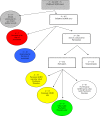Mortality, ADHD, and psychosocial adversity in adults with childhood ADHD: a prospective study
- PMID: 23460687
- PMCID: PMC3821174
- DOI: 10.1542/peds.2012-2354
Mortality, ADHD, and psychosocial adversity in adults with childhood ADHD: a prospective study
Abstract
Objective: We examined long-term outcomes of attention-deficit/hyperactivity disorder (ADHD) in a population-based sample of childhood ADHD cases and controls, prospectively assessed as adults.
Methods: Adults with childhood ADHD and non-ADHD controls from the same birth cohort (N = 5718) were invited to participate in a prospective outcome study. Vital status was determined for birth cohort members. Standardized mortality ratios (SMRs) were constructed to compare overall and cause-specific mortality between childhood ADHD cases and controls. Incarceration status was determined for childhood ADHD cases. A standardized neuropsychiatric interview was administered.
Results: Vital status for 367 childhood ADHD cases was determined: 7 (1.9%) were deceased, and 10 (2.7%) were currently incarcerated. The SMR for overall survival of childhood ADHD cases versus controls was 1.88 (95% confidence interval [CI], 0.83-4.26; P = .13) and for accidents only was 1.70 (95% CI, 0.49-5.97; P = .41). However, the cause-specific mortality for suicide only was significantly higher among ADHD cases (SMR, 4.83; 95% CI, 1.14-20.46; P = .032). Among the childhood ADHD cases participating in the prospective assessment (N = 232; mean age, 27.0 years), ADHD persisted into adulthood for 29.3% (95% CI, 23.5-35.2). Participating childhood ADHD cases were more likely than controls (N = 335; mean age, 28.6 years) to have ≥1 other psychiatric disorder (56.9% vs 34.9%; odds ratio, 2.6; 95% CI, 1.8-3.8; P < .01).
Conclusions: Childhood ADHD is a chronic health problem, with significant risk for mortality, persistence of ADHD, and long-term morbidity in adulthood.
Figures
References
-
- Barbaresi WJ, Katusic SK, Colligan RC, Pankratz VS, Weaver AL, Weber JK, et al. . How common is attention-deficit/hyperactivity disorder? Incidence in a population-based birth cohort in Rochester, Minn. Arch Pediatr Adolesc Med. 2002;156(3):217–224 - PubMed
-
- Froehlich TE, Lanphear BP, Epstein JN, Barbaresi WJ, Katusic SK, Kahn RS. Prevalence, recognition, and treatment of attention-deficit/hyperactivity disorder in a national sample of US children. Arch Pediatr Adolesc Med. 2007;161(9):857–864 - PubMed
-
- Barkley RA, Fischer M, Smallish L, Fletcher K. The persistence of attention-deficit/hyperactivity disorder into young adulthood as a function of reporting source and definition of disorder. J Abnorm Psychol. 2002;111(2):279–289 - PubMed
-
- Rasmussen P, Gillberg C. Natural outcome of ADHD with developmental coordination disorder at age 22 years: a controlled, longitudinal, community-based study. J Am Acad Child Adolesc Psychiatry. 2000;39(11):1424–1431 - PubMed
Publication types
MeSH terms
Grants and funding
LinkOut - more resources
Full Text Sources
Other Literature Sources
Medical


